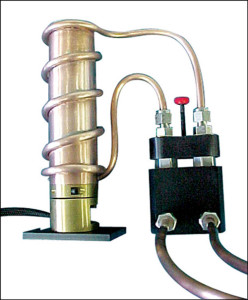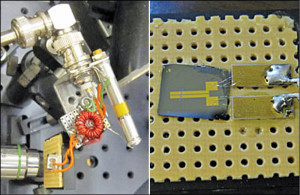The terahertz (THz) region (nominally 0.1-10THz) separates electronics from photonics, and has historically been difficult to access. Semiconductor electronics run out of steam after ~100GHz due to transport time limitations. Photonic devices falter below ~10THz because photon energy drops to thermal energy. At the high-frequency end, infra-red (IR) optoelectronics cannot operate significantly below 10THz. Since these devices employ photon-electron particle interactions, as photon energy hv decreases below thermal energy kT, the device ceases to operate efficiently unless it is cooled down. This adds significant cost and weight. At the low-frequency end, semiconductor electronic devices cannot operate at frequencies significantly above 100GHz. Transport time across the semiconductor junction is limited by drift and diffusion speeds. The largely-untapped frequency region between 100GHz and 10THz (the THz region) holds promise for a wide range of commercial and military applications. Terahertz electronics (TE) is a new technology that extends the range of electronics into the THz-frequency region.

Terahertz electronics
Terahertz electronics technology opens up practical applications in high-speed data interconnects, THz imaging, and highly-integrated radar and communication systems. The gap between electronics and photonics has closed. Further use and development of such technological devices will make TE a reality in the near future. It does not use semiconductors; instead, it is based on metal-insulator tunnelling structures to form diodes for detectors and ultra-high-speed tunnelling transistors for oscillator based transmitters. With these devices, detectors and transistors for operation in the THz region have been designed. Besides being extremely fast, TE devices are made entirely of thin-film materials—metals and insulators—and so may be fabricated on top of complementary metal oxide semiconductor (CMOS) circuitry—a technology for constructing integrated-circuits circuitry or on a wide variety of substrate materials.
Based on metal-insulator tunnel junctions, TE technology extends the range of electronics beyond the 100GHz barrier to 10THz. In these devices, charge transport through the junction occurs via electron tunnelling, which has a time constant of ~10–15 seconds. Charge transport to and from the junction occurs via plasma oscillation in metals, which is easily supported with low loss in the THz range of interest. Furthermore, epitaxial growth and high process temperatures are not required. Thus, integration of TE onto low-loss insulating substrates (for example, glass, sapphire, ceramic or plastic) or onto silicon-integrated circuits is possible. Industries are employing this concept in practical components, like detectors, transistors, mixers and other devices, to provide a full suite of ultra-fast integrated components for building high-frequency electromagnetic wave circuits and systems. The result is complete integrability, and consequently, low cost. In addition, devices may be fabricated onto large-area flat panels or flexible sheets, enabling completely integrated microwave/millimetre-wave/sub-millimetre-wave sensor and emitter arrays. These devices operate at low voltages, allowing compatibility with CMOS circuitry, coupled with innovations in antenna design and travelling wave devices. This leap in performance and flexibility enables a host of new applications for TE.
Sources of terahertz radiations

One of the main reasons that THz applications have not fully materialised yet is the lack of a small, low-cost, moderate-power THz source. THz radiations are generally emitted as a part of black-body radiation from anything with temperatures greater than 10 kelvin. While this thermal emission is very weak, observations at these frequencies are important for characterising the cold 10-20K dust in the interstellar medium. However, the opacity of the Earth’s atmosphere to sub-millimetre radiation restricts these observatories to very high altitude sites, or to space. About a decade back the only viable sources of THz radiation were:
1. The gyrotron
2. The backward-wave oscillator (BWO)
3. The far IR laser (FIR laser)
4. Quantum cascade laser
5. The free electron laser (FEL)
6. Synchrotron light sources
7. Photo-mixing sources
8. Single-cycle sources used in THz time domain spectroscopy, such as hoto-conductive, surface field, photo-dember and optical-rectification emitters

There have also been solid-state sources of millimetre and sub-millimetre waves for many years. Nowadays, most time-domain work is done via ultra-fast lasers. In mid 2007, scientists announced the creation of a compact device that can lead to portable, battery-operated sources of T-rays, or THz radiation. This new T-ray source uses high-temperature superconducting crystals that comprise stacks of Josephson junctions that exhibit a unique electrical property—when an external voltage is applied, an alternating current will flow back and forth across junctions at a frequency proportional to the strength of the voltage (phenomenon known as Josephson effect). These alternating currents then produce electro-magnetic fields whose frequency is tuned by the applied voltage. Even a small voltage, around two millivolts per junction, can induce frequencies in the THz range.






